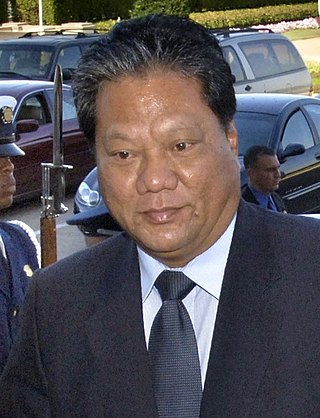
The Marshall Islands, officially the Republic of the Marshall Islands, is an island country near Kiribati in the Pacific Ocean, slightly west of the International Date Line and just north of the equator. Geographically, the country is part of the larger island group of Micronesia.

Micronesia is a subregion of Oceania, consisting of about 2,000 small islands in the Northwestern Pacific Ocean. It has a close shared cultural history with three other island regions: Maritime Southeast Asia to the west, Polynesia to the east, and Melanesia to the south—as well as with the wider community of Austronesian peoples.
Austronesian settlers arrived in the Marshall Islands in the 2nd millennium BC, but there are no historical or oral records of that period. Over time, the Marshallese people learned to navigate over long ocean distances by proa canoe using traditional stick charts.

Kessai Hesa Note was President of the Marshall Islands from 2000 to 2008.

Amata Kabua was the first President of the Marshall Islands from 1979 until his death in 1996.

Bokak Atoll or Taongi Atoll is an uninhabited coral atoll in the Ratak Chain of the Marshall Islands, in the North Pacific Ocean. Due to its relative isolation from the main islands in the group, Bokak's flora and fauna has been able to exist in a pristine condition.
The Micronesians or Micronesian peoples are various closely related ethnic groups native to Micronesia, a region of Oceania in the Pacific Ocean. They are a part of the Austronesian ethnolinguistic group, which has an Urheimat in Taiwan.

Likiep Atoll is a coral atoll of 65 islands in the Pacific Ocean, and forms a legislative district of the Ratak Chain of the Marshall Islands. It is approximately 55 kilometers (34 mi) northwest of Wotje. Its total land area is only 10.26 square kilometers (3.96 sq mi), but that encloses a deep central lagoon of 424 square kilometers (164 sq mi). Likiep Atoll also possesses the Marshall Islands' highest point, an unnamed knoll 10 meters (33 ft) above sea level. The population of Likiep Atoll was 401 in 2011.

Stick charts were made and used by the Marshallese to navigate the Pacific Ocean by canoe off the coast of the Marshall Islands. The charts represented major ocean swell patterns and the ways the islands disrupted those patterns, typically determined by sensing disruptions in ocean swells by islanders during sea navigation.

The Belau National Museum (BNM), previously Palau Museum, is a museum in Koror, Palau. It is the oldest continuously run museum in Micronesia.
Japanese settlement in the Marshall Islands was spurred on by Japanese trade in the Pacific region. The first Japanese explorers arrived in the Marshall Islands in the late 19th century, although permanent settlements were not established until the 1920s. As compared to other Micronesian islands in the South Seas Mandate, there were fewer Japanese who settled in the islands. After the Japanese surrender in 1945, the Japanese populace were repatriated to Japan, although people of mixed Japanese–Marshallese heritage remained behind. They form a sizeable minority in the Marshall Islands' populace, and are well represented in the corporate, public and political sectors in the country.
The Joachim DeBrum House, known simply as the DeBrum House and also spelled Debrum House or De Brum House, located on Likiep Island, of Likiep Atoll, in the Marshall Islands, is a plantation house that was built in 1888 by Joachim deBrum. It was listed on the United States National Register of Historic Places in 1976, making it the first NRHP site in Micronesia.

Wa are traditional sailing outrigger canoes of the Caroline Islands, Palau, and Yap. They have a single outrigger. They are similar to the sakman of the Northern Marianas.

Tony deBrum was a Marshallese politician and government minister. His cabinet posts included Minister in Assistance to the President of Marshall Islands, Minister of Finance, Minister of Foreign Affairs and Minister of Education.
Carmen Milne Bigler is a Marshallese educator, civil servant and former politician. She was the first and only woman to serve in the Congress of the Trust Territory of the Pacific Islands.
Kosrae State Museum is a museum in Tofol in Kosrae State in the Federated States of Micronesia.
The Lidorkini Museum was a museum in Kolonia on the island of Pohnpei, in the Federated States of Micronesia.
Mary Heine Lanwi is an educator, activist, and promotor of traditional handicrafts in the Marshall Islands. A female pioneer on the islands, she has been described as "perhaps the first Marshallese woman to begin employment outside the home." In 1974, she was the only woman elected to serve as a delegate to the Micronesian Constitutional Convention.






















